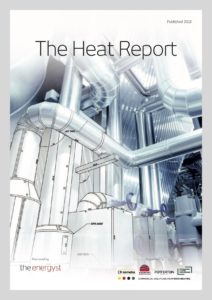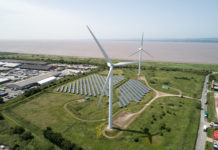 Hydrogen is seen as a key option for decarbonising gas and therefore heat. Some studies suggest it could reduce emissions from heat by almost three quarters, while also helping to decarbonise transport, power and industry. So what’s the catch?
Hydrogen is seen as a key option for decarbonising gas and therefore heat. Some studies suggest it could reduce emissions from heat by almost three quarters, while also helping to decarbonise transport, power and industry. So what’s the catch?
The Committee on Climate Change has repeatedly called for “proper” hydrogen trials so that decisions on whether to pursue hydrogen can be taken in the early 2020s.
Proponents of hydrogen believe it is the least disruptive option, because it enables reuse of existing gas infrastructure and is not reliant on behavior change from consumers. It could also enable highly efficient decentralised combined heat and power as well as decarbonise transport, they suggest.
The challenge lies in decarbonising hydrogen production. Hydrogen via electrolysis could be achieved from renewables (with firms such as Vattenfall stating intent), but it is expensive and at scale would require vast amounts of renewable generation.
Hydrogen via steam methane reforming (SMR, which uses high levels of heat to crack methane into carbon and hydrogen) is cheaper and more immediately scalable, but its carbon emissions are high.
So SMR requires carbon capture and storage (CCS) to transport emissions offshore and into depleted North Sea wells or salt caverns.
CCS: Risk and reward
CCS features prominently in most 2050 scenarios aiming to limit climate change to non-catastrophic levels.
CCS advocates argue that its component technologies are tried and tested, pointing to projects around the world. Meanwhile, according to studies delivered by the Energy Technologies Institute, the UK has vast storage resources (equivalent to 78,000 million tonnes), and world-class oil and gas expertise.
But CCS is not really proven at scale, and convincing investors to back it, even if their investment is de-risked by tax- or bill-payers, might prove challenging.
The last government axed the £1bn CCS fund to decarbonise power generation in 2015. This government has so far put £100m on the table. While that sum is insignificant in CCS terms, those backing hydrogen believe CCS is gaining political momentum – this time focusing on decarbonising heat and industry rather than power generation.
‘CCS anchor projects’
The hydrogen trials urged by the Committee on Climate Change are starting to take shape.
A consortium led by gas networks officially launched the HyDeploy project at the end of February. Cadent and Northern Gas Networks believe such trials lay the groundwork for development of CCS hubs.
HyDeploy is funded by bill payers under Ofgem’s Network Innovation Allowance programme. It aims to inject a gas blend of up to 20% hydrogen across Keele University’s private gas network to determine how much hydrogen could be safely used within existing infrastructure without affecting gas appliances.
Under the HyDeploy trial, hydrogen will be created via electrolysis, which breaks up water molecules into hydrogen and oxygen. But Northern Gas Networks CEO, Mark Horsley, said the firm “makes no bones” about the fact large scale deployment of hydrogen within gas networks will require CCS.
However, he said if hydrogen can be proven safe at significant concentrations within gas networks, it would create “anchor projects for people wanting to build carbon capture networks” and make them “more viable”.

David Parkin, director, network strategy at Cadent, admitted that CCS support has a “chequered history” in the UK. However, Parkin said he is “very confident that the government is now focused on delivering CCS … [Beis] and the Committee on Climate Change have said that the UK will not achieve 2050 carbon targets without it”.
Plastic enabler
Using higher blends of hydrogen in the gas network will require plastic pipes. The UK-wide iron ring main replacement programme is now about 70% complete, according to Horsley, and should be 100% complete by 2032, potentially creating strong alignment for higher hydrogen use in the next decade.
Hydrogen appliances
While gas appliances manufactured after 1996 are designed to operate with a hydrogen mix up to 23%, the government is funding a £25m project to determine implications of higher hydrogen blends for equipment such as cookers and boilers. Horsley suggested the Beis appliance funding and Ofgem innovation allowances indicate that “government, regulator and industry are ensuring the requisite [hydrogen] elements are joined up”.
Profit before purpose?

Horsley rebutted claims by The Energy Research Centre suggesting gas networks may be “promoting [hydrogen] options which clearly cannot deliver a transformation to low carbon heat … as a means to progress their own financial agenda”.
“That is not fair comment,” said Horsley. “There is not a silver bullet in any solution and we do not preclude that as an industry. We very much support the work of the electricity sector, but different circumstances require different solutions. So I can categorically state that [progressing a financial agenda] is not the case.
“We are very confident about the technology – hydrogen production is a known technology – but there is potential to use the pipe network for other bio- or synthetic gases. So we think the project has a real merit, but, at the same time, we are not precluding other solutions.”
Warm Leeds
Northern Gas Networks (NGN) is also exploring hydrogen use in Leeds to determine whether the city – and ultimately the rest of the UK’s gas networks – could be incrementally converted to hydrogen.
The H21 Leeds City Gate project suggested converting gas networks across the UK to hydrogen could cut emissions from heat by 73%, if CCS infrastructure is in place, according to NGN. The firm estimated the cost of converting the Leeds city network to hydrogen, including CCS infrastructure, would be around £2bn. Of that, just over half (£1.05bn) relates to changing household and business appliances, with just under half (£970m) relating to hydrogen and CCS infrastructure.
NGN claimed if funded under the current regulatory regime, converting Leeds to run on hydrogen would have “negligible impact on customers total gas bills”.
However, the gas network said Ofgem would need to provide “clear direction” that networks must make provisions for hydrogen conversion within their next price controls, which are currently out for consultation.
Meanwhile, NGN said government would need to commit to a hydrogen conversion strategy by 2021/22.
CCS: Damned if you don’t?
The government’s Clean Growth Strategy put CCS, or CCUS (carbon capture, utilisation and storage) back on the agenda. It announced a CCUS cost reduction task force, which is scheduled to report back to government by the end of 2018, and £100m of potential CCUS innovation funding.
In March MPs questioned energy minister Claire Perry about the government’s appetite for CCS, with Alan Whitehead, MP for Southhampton Test, stating “£100 million will not get us anywhere near our CCS target”.

In response, Perry highlighted concerns around cost:
“There are only 21 at-scale CCS plants working in the world today, 16 of which rely on capturing the carbon and using it for enhanced oil recovery. This is not a cost-effective technology that other countries are embracing with gusto. Even our friends in Norway, who are a little further along than us in building up the infrastructure, are struggling with precisely this point, which is, how much do we burden taxpayers or consumers to fund these projects? That is a real challenge.”
However, said Perry, “we are not going to bow down before it; we are going to embrace it.”
There are “enormous opportunities to work with the hydrogen economy and with heating systems, to try to bring this work together”, added Perry. “We understand completely the need to decarbonise these industrial pools and to decarbonise further our heating system. Without CCS and CCUS, I do not believe that we can do that, which is why they are such vital technologies.”
‘Award CCS contracts by 2020’
In its 2017 annual report to Parliament, the Committee on Climate Change urged government to get on with developing a CCS strategy. It recommended government set out:
‘A new strategic approach to carbon capture and storage (CCS) deployment in the UK, including preparations for possible use in the production of low-carbon hydrogen. CCS could enable large-scale emissions reduction from electricity generation and industry, plus the production of hydrogen. The new approach should include separation of support for CO2 infrastructure, a new funding mechanism for industrial CCS and some sharing of risks across parties, and with Government, especially where they reflect future policy uncertainty. Contracts should be awarded by 2020 to allow operations at scale in the 2030s.’
Hydrogen options and tradeoffs
Hydrogen can be produced via electrolysis from renewable energy without the need for CCS, but that method is expensive and at scale would require huge volumes of renewable generation. However, costs would likely be driven down by economies of scale and using excess renewables to produce hydrogen would simultaneously solve challenges within the power system.
Delivering hydrogen through steam methane reforming (SMR) is cheaper, but without CCS, will push up emissions.
A paper published in July 2017 by the Sustainable Gas Institute at Imperial College outlines estimates of the range of CO2 emissions from producing hydrogen. It states:
‘The highest and most variable emissions come from fossil fuel routes to produce hydrogen that do not include CCS. These technologies are likely to produce carbon intensities greater than current gas networks. CCS is therefore needed to ensure this gas is low carbon.’
The paper continues: ‘Emissions estimates for SMR with CCS are between 23 to 150gCO2 eq/kWh, while for electrolysis using renewable electricity sources the range is from 25 to 178gCO2 eq/kWh. The carbon intensity of heat might be between 26 and 167gCO2 eq/kWh for methane-based hydrogen and 27 to 198gCO2 eq/kWh for hydrogen from electrolysis, assuming a 90% efficient hydrogen boiler. Heat pumps with 250% efficiency using the same electricity might deliver heat with a CO2 intensity of 10 to 71 gCO2 eq/kWh.’
Hydrogen the cheaper option?
A 2016 report by KPMG, commissioned by the Energy Networks Association suggested a hydrogen pathway using CCS could be £150-£214bn cheaper than electrification, although its estimates do not include the ongoing cost of maintaining North Sea carbon storage facilities.
 A version of this article was published in The Energyst’s latest Heat Report. The report contains alternative views on decarbonising heat, as well as a survey of end users to gauge views on lower carbon heating opportunities and challenges.
A version of this article was published in The Energyst’s latest Heat Report. The report contains alternative views on decarbonising heat, as well as a survey of end users to gauge views on lower carbon heating opportunities and challenges.
Download the report here, free of charge.
Related stories:
Cadent plans major hydrogen plus carbon capture and storage push
Can wind, rocks, coal mines and salt decarbonise heat?
Vattenfall backs hydrogen to decarbonise heavy industry, eyes supply chain
Eon boss: Renewable power is ‘done’, now for heat and transport
Hydrogen for heat ‘will create anchor carbon capture and storage projects’
Climate Change Committee calls for ‘proper’ hydrogen trials
Click here to see if you qualify for a free subscription to the print magazine, or to renew.
Follow us at @EnergystMedia. For regular bulletins, sign up for the free newsletter.




CCS is a stop-gap to help us get to zero carbon by 2050, as is burning a small proportion of hydrogen in gas for heating, as a high level of hydrogen will embrittle the steel gas pipes. The long term for heating must be largely ground source heat pumps that extract energy from the earth: 4 times as much heat as the electric power to run them.
The bottom line in the carbon zero energy production has to be everything powered by electricity, with much delivered in its portable form in batteries or hydrogen gas in tanks. This can’t be achieved by wind, PV, hydro, waves etc alone as in the UK, green electricity is only some 5% of the 2,234 TWh of all energy production (2018 figures from BEIS). There needs to be a massive building programme of nuclear fission power stations to fill the gap. A political hot potato?